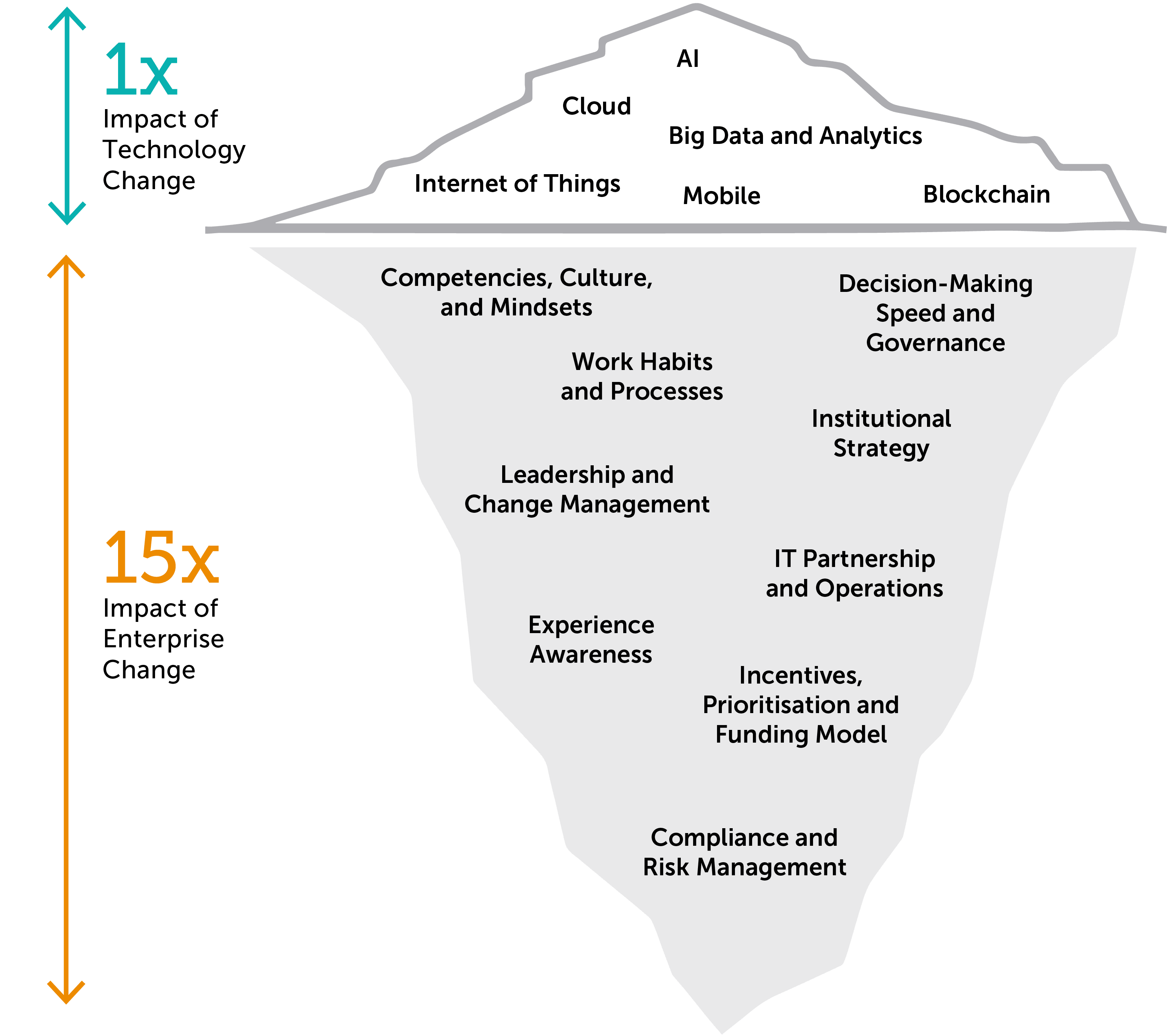Digital Transformation
What is digital transformation?
Digital transformation—it’s the buzziest of buzzwords, a Rorschach test for everything one might see as good or bad in higher education, either a panacea or a poison pill.
In the wake of 2020’s pandemic-induced shift to remote instruction and operations, even the most stalwart opponents of expanding the use of digital technologies in the modern university were seemingly won over.
Of course, the adoption and application of digital technologies looks different from this side of the pandemic, when not mandated by widespread lockdowns. Nonetheless, even if the urgency has tempered, there’s no denying the evolution of sector-wide attitudes on the role of digital technologies. The question on leaders’ minds is therefore less about whether to pursue a digital transformation agenda, but rather which of many opportunities should be prioritised, and how quickly progress can be made.
But what, exactly, is digital transformation? How do discerning leaders ensure they invest only in solutions that actually move the needle on financial, operational, or strategic objectives?
This executive brief will give you the answers you’ve been looking for, starting with a better understanding of digital transformation and the challenges of pursuing it in the higher education sector. In addition to providing examples of where digital transformation investments have been most successful in addressing strategic and operational challenges, this brief also outlines the core organisational capabilities necessary for change.
Navigate through the brief by selecting from the list below to dive into the specific section.
What is digital transformation?
The beginning of wisdom is the definition of terms
In response to consumer and environmental pressures amplified by a global pandemic, higher education institutions are rapidly embracing ‘digital transformation’. But like many buzzwords, the term is only useful in the context of a shared definition. Here’s ours:
Digital transformation is the process of using digital tools—specifically data and technology—to deliver value and drive change.
The emphasis is not on specific technologies but on the application of those technologies to core strategies or operational challenges.
The rapid scaling and widespread adoption of the solution in turn creates a culture of continuous improvement and sets the stage for further transformation.
What digital transformation is and is not
Not
Why has digital transformation been elusive?
For universities, moving from slogan to impact frustratingly difficult
It’s not hard to become enthusiastic—or even optimistic—about the potential for digital transformation in higher education. After all, the sector’s incredible accomplishments during the pandemic prove that change is possible. You likely have a running list of opportunities that you would prioritise on your campus. On top of that, you probably hear pitches almost every day from vendors suggesting solutions to problems you didn’t know you had.
Still, on many campuses, true digital transformation remains elusive. Both before and after the pandemic, institutions have reported that moving from a public declaration of a commitment to digital transformation to actual impact has been no easy task.
The culprit is twofold: barriers to innovation and barriers to scale. Many institutions find themselves stuck in one of two scenarios, depicted below. In the upper left quadrant, digital substitution, in which a new technology replaces an analogue way of working without significantly improving the customer value or experience. In this scenario, scale is easier to achieve because the barriers related to changing existing infrastructure, business process, and roles and responsibilities are lower. In the lower right quadrant, there’s innovation theatre. Genuinely new approaches and technologies may pop up around campus, but they remain isolated, sub-scale, and consequently of little impact.
True digital transformation overcomes both barriers. It introduces new ways of carrying out core activities – and does so at scale, allowing for the greatest opportunities for financial, operational, or mission impact.
Campus technology projects often stumble on two barriers on path to genuine transformation
Barriers to innovation
- Staff lack expertise and incentive to ‘design-in’ new technologies
- No ownership for systematically evaluating opportunities for transformation
- Siloed, manual business processes reinforce a ‘we’ve always done it this way’ attitude
Barriers to scale
- Individual units lack funding and support to pursue initiatives by themselves
- Legacy IT infrastructure and lack of data standards prevent interoperability
- Central administrators struggle to get units to agree on requirements
Where have other universities succeeded?
The best path forward? Align technology investments with institutional mission
The most impactful projects will enhance value and differentiate your institution
As individual campuses look to leverage the new capabilities afforded by digital technologies, they should do so in ways that enhance the value drivers of the institution.
The typical higher education institution carries out thousands of processes and services in delivering its learning and teaching product. Amongst those workflows, some are central to the delivery of institutional missions, while others function as enablers of those core values.
EAB research has identified six domains in which investments in digital transformation consistently yield positive results. While technologies and vendors will come and go, focusing on these domains will keep you on the path towards transformation. Read on for detail on each of the domains and snapshots of a few high-impact investments in each.
Proven domains of digital transformation success
How do we prepare the institution for change?
Organisational culture dictates direction and magnitude of change
Technology provides opportunity, but people ultimately enable campus success
Emerging technologies and digital solutions, like those outlined across the previous pages, offer exciting possibilities for transforming core strategic and operational activities. But more than any tool, app, or interface, the leadership of a university will be most influential in determining the success of digital transformation initiatives.
Innovation thrives only in the right environment, and a culture of collaboration, risk-taking, and business partnership across the organisation provides the most fertile ground for digital endeavours.
Driving successful change and improving value for students and staff means finding support amongst the people and processes that govern the institution. Without a culture of fostering, incubating, and adopting innovative solutions, institutions will see technology spend rise, with little to show for their investments.
In pursuing digital transformation, cultural challenges always lurk beneath technological change

Core tasks of senior leaders on the digital transformation journey
- Bridge siloed mindsets and cultures
- Overcome aversion to risk and failure
- Encourage iterative, collaborative work
- Focus on ‘customer’ journeys and experience
- Develop shared digital ambitions and goals
- Seek out partnerships for solution building
- Increase speed of campus decision-making
Elevate digital awareness and promote a shared language for problem solving
Embedding digital thinking at the senior level yields a unified vision and cross-functional collaboration
To foster digital success, institutions must elevate leadership awareness of technology-enabled capabilities and incorporate value-focused models of thinking. When senior leaders share a common framework of problem-driven analysis for understanding and evaluating digital opportunities, their campuses will see better outcomes.

Leadership checklist for pursuing enterprise-level digital transformation ambitions
- Provide clarity around institutional goals: Create a shared definition and vocabulary for digital transformation; rally campus around common objectives
- Formalise a problem identification process: Solicit input to identify cross-campus problems that could be solved through digital transformation
- Promote digital ownership beyond IT: Create clarity around investment decisions, resource allocation, and project responsibility
- Build a portfolio view of initiatives: Uncover digital projects, reconcile overlaps and conflicts, and advocate for a coherent enterprise architecture
- Normalise an ethic of assessment: Measure digital project returns and focus on accountability through sunsetting and scaling innovations appropriately
- Invest in a data hub for a single source of truth: Establish a system- and vendor-agnostic view of campus data to support information integrity and reusability as campus priorities and digital investments evolve over time
Learn how EAB can partner with you
Foundational questions for embedding digital perspectives in campus strategy conversations
- How do emerging technologies impact our strategic goals and objectives?
- What are the core values and differentiators of our institution?
- Where do organisational silos hinder the creation of new solutions?
- How can we improve IT’s capacity to support ongoing digital projects?
- Where are we already innovating successfully, and can it work at scale?
Prepare Your Institution for Change by Completing a Digital Transformation Capabilities Assessment
What’s next in a digital transformation journey?
Digital transformation does not happen by itself; rather, it requires the development of concrete practices, infrastructure, and skills—collectively, capabilities—that create an environment in which transformation can flourish.
Specifically, digital transformation requires both organisational capabilities, which help drive cultural change, as well as IT capabilities, which ensure the technological infrastructure is equipped for transformation at scale.
Senior leaders play an important role in working across campus to establish a shared understanding and identify problems (and opportunities) requiring digital solutions. IT units must be able to respond thoughtfully and partner effectively with different areas of the institution to design, implement, and monitor innovation initiatives.
Learn more about these capabilities – what they are and how to build them – in EAB’s digital transformation resource center.
More Resources

How EAB's Edify Makes Your LMS Data Actionable

Organizational Transformation Resource Center for Higher Ed
